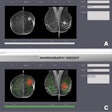Male radiologists are more likely to be sued than female radiologists, while those from Utah have the highest likelihood of being subjected to a malpractice claim of any U.S. state, according to a study presented at the recent RSNA 2011 meeting.
Researchers at the University of Medicine and Dentistry of New Jersey found that the chance of a male radiologist being sued by the age of 60 was 50%, compared with 40% for female radiologists of the same age.
Dr. Jeremy Whang presented findings from a study he conducted with Dr. Stephen Baker and colleagues to explore the demographics of radiology malpractice suits in a survey that included 8,401 radiologists.
Whang's team evaluated the malpractice histories of this cohort using credentialing information required of all radiologists who participate in the One Call Medical network of Parsippany, NJ, a broker for CT and MR studies in workers' compensation cases. The data included information from radiologists in 47 states.
Of the 8,401 radiologists included in the study, 2,624 (31%) had experienced at least one malpractice claim. Utah radiologists had the highest likelihood of being sued at least once (55%), while Wisconsin radiologists had the lowest likelihood (14%). New York state had the greatest number of suits per capita, at 1.2 per radiologist, while Alabama had the least number of suits, at 0.18 per radiologist.
Louisiana radiologists had the greatest risk of an unfavorable judgment or settlement, while Indiana radiologists had the least risk, Whang's team found.
In terms of gender, male radiologists had a greater chance of being sued than their female counterparts, with 33.8% of the men in the study experiencing claims against them, compared with 24.4% of the women.
Suits rarely based on failure to recommend exams
Failing to recommend an additional diagnostic test was rarely a source of malpractice claims, according to research Baker presented later in the session.
Using the same data he and Whang had used, Baker found that of 4,073 malpractice claims, only 51 (1.2%) were based on the alleged failure of a radiologist to recommend an additional test or procedure. In six of these, the test in question did not involve imaging.
Of the other 45 cases, 18 concerned breast disease; 89% of these breast-related claims resulted in a settlement in favor of the plaintiff, with an average reward of $265,259. The remaining 27 malpractice claims were nonbreast cases, encompassing only 0.6% of overall malpractice claims (of these, the most common modality allegedly not recommended was CT). Fifty-one percent of these suits resulted in a judgment in favor of the plaintiff, with an average settlement of $228,935, according to Baker and his team.
"Despite a wide perception that radiologists should make and record recommendations for additional testing to avoid malpractice, the data indicate that outside of breast radiology, failure to recommend additional tests as a primary allegation is very rare," Baker told session attendees. "The impetus of radiologists to recommend additional tests to avoid liability exposure is not borne out by the [actual amount] of such cases in the malpractice histories of approximately one-third of all currently practicing American radiologists."















